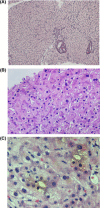AASLD practice guidance on drug, herbal, and dietary supplement-induced liver injury
- PMID: 35899384
- PMCID: PMC9936988
- DOI: 10.1002/hep.32689
AASLD practice guidance on drug, herbal, and dietary supplement-induced liver injury
Conflict of interest statement
Victor Navarro received grants from Zydus. Robert Fontana received grants from Gilead. William Lee consults for SeaGem, GSK, Forma, and Veristat. He received grants from Eiger, Alexion, Gilead, Boehringer Ingelheim, Lipocine, and Camurus.
Figures


Comment in
-
AASLD practice guidance on drug, herbal, and dietary supplement-induced liver injury: also useful for hepatobiliary surgeons.Hepatobiliary Surg Nutr. 2023 Oct 1;12(5):746-751. doi: 10.21037/hbsn-23-319. Epub 2023 Sep 13. Hepatobiliary Surg Nutr. 2023. PMID: 37886185 Free PMC article. No abstract available.
-
Update on herbal and dietary supplement-induced liver injury: current gaps and future directions.Hepatobiliary Surg Nutr. 2023 Oct 1;12(5):752-755. doi: 10.21037/hbsn-23-329. Epub 2023 Sep 1. Hepatobiliary Surg Nutr. 2023. PMID: 37886208 Free PMC article. No abstract available.
References
-
- Bakke OM, Manocchia M, de Abajo F, Kaitlin KI, Lasagna L. Drug safety discontinuation in the UK, the United States, and Spain from 1974 to 1993: a regulatory perspective. Clinic Pharmacol Ther. 1995;58:108–17. - PubMed
-
- Hales CM, Servais J, Martin CB, Kohen D. Prescription drug use among adults aged 40–79 in the United States and Canada. NCHS Data Brief. 2019;334:1–8. - PubMed
-
- Björnsson ES, Hoofnagle JH. Categorization of drugs implicated in causing liver injury: critical assessment based on published case reports. Hepatology. 2016;63:590–603. - PubMed
Publication types
MeSH terms
LinkOut - more resources
Full Text Sources
Medical

